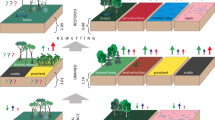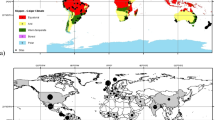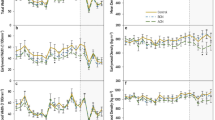Abstract
Water use efficiency (WUE) was compared in three upland South Moravian forested microwatersheds in the light of effects of global climate change on forest ecosystems (GCC). The experimental catchments were characterized as upland headwater forested microwatersheds of similar size and morphology and silvicultural system, but each with different dominant tree species in the stands (over 50% of forest stand composition in living stock): Norway spruce, European beech and mixed forest. WUE was evaluated according to mean daily streamflow reduction, measured at the discharge points of the recipients of the individual catchments in precipitation-free periods lasting more than 5 days. During these times, streamflow dynamics are mainly influenced by evapotranspiration processes occurring in the forest stands. Four precipitation-free periods were observed, two in the middle of the growing season and two at its end. Two of these periods were long (15 days or more), and two were shorter (6 days). The results indicated that WUE of upland forested catchments can be very different, depending upon the dominant tree species and the seasonal phase. Highest WUE at the catchment scale (never decreasing below 80%) was exhibited by beech predominating site. WUE of mixed forest was high as well, never decreasing below 69%. The lowest WUE was exhibited by spruce predominating site, especially during a long precipitation-free period in the summer where it decreased down to 39%. In the context of the landscape, upland microwatersheds with pure spruce stands could cause its accelerated dry out in the summer and pose a significant threat to sustainable water and forest management of these areas. In comparison, mixed forests stands where spruce is not the dominant species or beech stands should still be a viable option even under the effects of GCC.








Similar content being viewed by others
References
Adams HD, Guardiola-Claramonte M, Barron-Gafford GA, Villegas JC, Breshears DD, Zou CB, Troch PA, Huxman TE (2009) Temperature sensitivity of drought-induced tree mortality: implications for regional die-off under global-change-type drought. Proc Natl Acad Sci USA 106(17):7063–7066
Arthington AH, Naiman RJ, Mcclain ME, Nilsson C (2010) Preserving the biodiversity and ecological services of rivers: new challenges and research opportunities. Freshw Biol 55:1–16
Bajer A (2015) a kol. Krajina a geodiverzita: neživá příroda jako základ krajinných a kulturních hodnot. Brno: Mendelova univerzita v Brně. 159 s. ISBN 978-80-87443-11-8
Bates BC, Kundzewicz ZW, Wu S, Palutikof JP (eds) (2008) Climate change and water. Technical paper of the intergovernmental panel on climate change. IPCC Sec-retariat, Geneva. Accessed July 10, 2013. www.ipcc.ch/pdf/tec
Beerling DJ (1999) Long-term responses of boreal vegetation to global change: an experimental and modelling investigation. Glob Change Biol 5:55–74
Binkley D, Stape JL, Ryan MG (2004) Thinking about efficiency of resource use in forests. For Ecol Manag 193:5–16. https://doi.org/10.1016/j.foreco.2004.01.019
Bokhorst S, Bjerke JW, Bowles FW, Melillo J, Callaghan TV, Phoenix GK (2008) Impacts of extreme winter warming in the sub-Arctic: growing season responses of dwarf shrub heathland. Glob Change Biol 14:2603–2612. https://doi.org/10.1111/j.1365-2486.2008.01689.x
Demek J (1987) Obecná geomorfologie. Praha: Academia, 476 s
Deutscher J, Kupec P (2014) Monitoring and validating the temporal dynamics of interday streamflow from two upland head microwatersheds with different vegetative conditions during dry periods of the growing season in the Bohemian Massif, Czech Republic. Environ Monit Assess. https://doi.org/10.1007/s10661-014-3661-5
Deutscher J, Kupec P, Dundek P, Holík L, Machala M, Urban J (2016) Diurnal dynamics of streamflow in an upland forested micro-watershed during short precipitation-free periods is altered by tree sap flow. Hydrol Process 30(13):2042–2049. https://doi.org/10.1002/hyp.10771
Dubrovský M, Trnka M, Holman IP, Svobodová E, Harrison PA (2015) Developing a reduced-form ensemble of climate change scenarios for Europe and its application to selected impact indicators. Clim Change 128:169–186. https://doi.org/10.1007/s10584-014-1297-7
Frich P, Alexander LV, Della-Marta P, Gleason B, Haylock M, Klein Tank AMG, Peterson T (2002) Observed coherent changes in climatic extremes during the second half of the 20th century. Climate Res 19:193–212
Graham CB, Barnard HR, Kavanagh KL, McNamara JP (2013) Catchment scale controls the temporal connection of transpiration and diel fluctuations in streamflow. Hydrol Process 27:2541–2556. https://doi.org/10.1002/Hyp.9334
Grelle A, Lundberg A, Lindroth A, As Moren, Cienciala E (1997) Evaporation components of a boreal forest: variations during the growing season. J Hydrol 197:70–87
Hasper TB, Wallin G, Lamba S, Hall M, Jaramillo F, Laudon H, Linder S, Medhurst JL, Rantfors M, Sigurdsson BD, Uddling J (2016) Water use by Swedish boreal forests in a changing climate. Funct Ecol 2016(30):690–699. https://doi.org/10.1111/1365-2435.12546
Huxman TE, Smith MD, Fay PA, Knapp AK, Shaw MR, Loik ME et al (2004) Convergence across biomes to a common rain-use efficiency. Nature 429:651–654
IPCC (2013) Climate change 2007: the physical science basis. Technical report. In: Solomon S, Qin D, Manning M, Chen Z, Marquis M, Averyt KB, Tignor M, Mille HL (eds) Conntribution of working group I to the fourth assessment report of the intergovernmental panel on climate change. Ambridge University Press, Cambridge, p 996
Kolář T, Giagli K, Trnka M, Bednářová E, Vavrčík H, Rybníček M (2016) Response of the leaf phenology and tree-ring width of European beech to climate variability. Silva Fennica 50(2):1520 ISSN: 00375330
Kolářová E, Nekovář J, Adamík P (2013) Long-term temporal changes in central European tree phenology (1946–2010) confirm the recent extension of growing seasons. Int J Biometeorol. https://doi.org/10.1007/s00484-013-0779-z
Kovář P, Bačinová H (2015) Impact of evapotranspiration on diurnal discharge fluctuation determined by the Fourier series model in dry periods. Soil Water Res 10(4):210–217
Lesprojekt Brno AS (2013) Forest Management Plan of the Training forest Enterprise Masaryk Forest Křtiny 2013–2022
Linderholm HW (2006) Growing season changes in the last century. Agric For Meteorol 137(2006):1–14
Ministry of Agriculture of the Czech Republic (2013) Information on forests and forestry in the Czech Republic by 2012. Prague 2013, p 35. www.eagri.cz
Pretzsch H, Biber P, Schütze G, Uhl E, Rötzer T (2014) Forest stand growth dynamics in Central Europe have accelerated since 1870. Nat Commun. https://doi.org/10.1038/ncomms5967
Quitt E (2009) Klimatické oblasti (1901–2000). Barevná mapa č. 38, 1: 1 000 000. In: Hrnčiarová T., Mackovčin P., Zvara I.: Atlas krajiny ČR. Ministerstvo životního prostředí ČR a Ústav Silva Taroucy pro krajinu a okrasné zahradnictví, Praha
Richter BD, Warner AT, Meyer JL, Lutz K (2006) Acollaborative and adaptive process for developing environmental flow recommendations. River Res Appl 22:297–318
Šach F, Švihla V, Černohous V, Kantor P (2014) Management of mountain forests in the hydrology of a landscape, the Czech Republic. J For Sci 60(1):42–50 (ISSN 1212-4834)
Schieber B, Janík R, Snopková Z (2013) Phenology of common beech (Fagus sylvatica L.) along the altitudinal gradient in Slovak Republic (Inner Western Carpathians). J For Sci 59(4):176–184
Schlesinger WH, Jasechko S (2014) Transpiration in the global water cycle. Agric For Meteorol 189–190:117–155
Švihla V (2001) Vliv lesa na odtokové poměry namalém povodí. Lesnická práce 2. http://www.silvarium.cz/lesnicka-prace-c-2-01/vliv-lesa-naodtokove-pomery-na-malem-povodi. Accessed Feb 5, 2014
Trenberth KE, Dai A, Rasmussen RM, Parsons DB (2003) The changing character of precipitation. Bull Am Meteor Soc 84:1205–1217
Troch PA, Martinez GF, Pauwels VRN, Durcik M, Sivapalan M, Harman C, Brooks PD, Gupta H, Huxman T (2009) Climate and vegetation water use efficiency at catchment scales. Hydrol Process 23:2409–2414
Vitasse Y, François C, Delpierre N, Dufrêne E, Kremer A, Chuine I, Delzon S (2011) Assessing the effects of climate change on the phenology of European temperate trees. Agric For Meteorol 151(7):969–980. https://doi.org/10.1016/j.agrformet.2011.03.003
Wang H, Tetzlaff D, Dick JJ, Soulsby Ch (2017) Assessing the environmental controls on Scots pine transpiration and the implications for water partitioning in a boreal headwater catchment. Agric For Meteorol 240–241(2017):58–66
Acknowledgments
Supported by the Project FRAMEADAPT Frameworks and possibilities of forest adaptation measures and strategies connected with climate change EHP-CZ02-OV-1-019-2014 and by Internal Grant Agency of the Faculty of Forestry and Wood Technology (IGA LDF), MENDELU in Brno as Project 17/2016.
Author information
Authors and Affiliations
Corresponding author
Additional information
Communicated by Agustín Merino.
Rights and permissions
About this article
Cite this article
Petr, K., Libor, Š. & Jan, D. Tree species composition influences differences in water use efficiency of upland forested microwatersheds. Eur J Forest Res 137, 477–487 (2018). https://doi.org/10.1007/s10342-018-1117-0
Received:
Revised:
Accepted:
Published:
Issue Date:
DOI: https://doi.org/10.1007/s10342-018-1117-0




